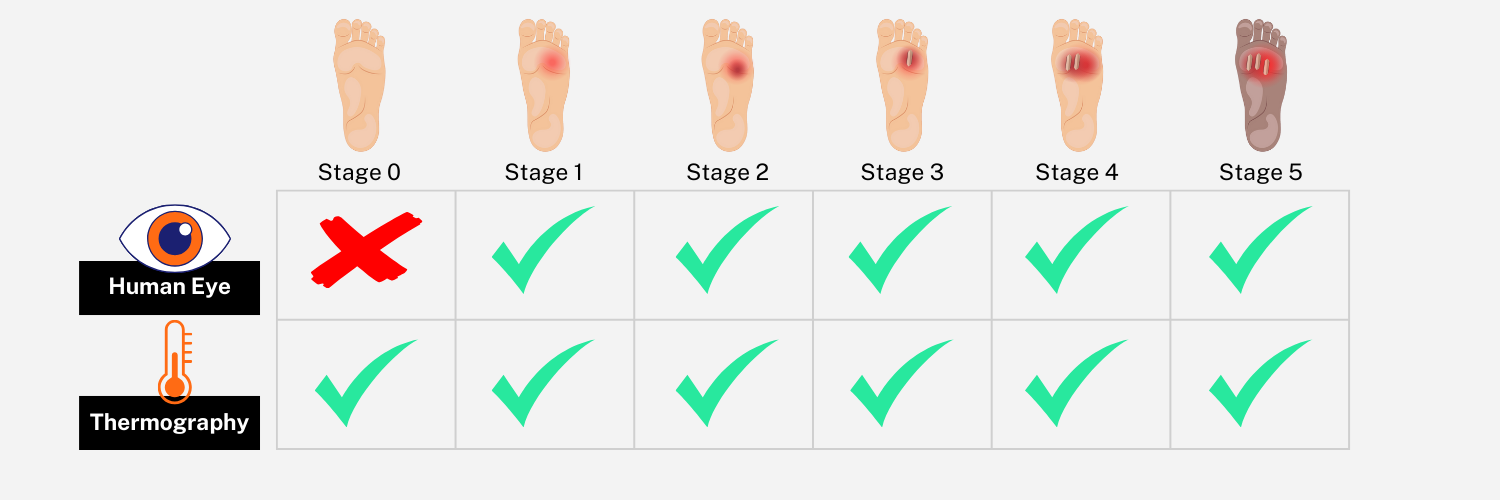Thank You for Taking the Feetsee Quiz!
We have analyzed your quiz answers and prepared some insights on how we can help you manage your foot health effectively.
Risk Factor: Tobacco use No
Smoking has extensive effects on all stages of diabetic foot ulcerations, both the onset and healing processes. Quitting smoking has been confirmed to be effective in reducing mortality and increasing amputation‐free survival. (6)
The good news that you are prescribed to use the Feetsee device by our HCP, now you can choose your best plan
Thermography Enables Early Foot Ulcer Detection


(7)


Rytis Zajanckauskas, MD
CEO, Feetsee
A Letter from the CEO
Diabetes is a significant health challenge affecting over 1 in 10 Americans, with 88 million adults at risk of developing the disease. Among those diagnosed, 9.6 million suffer from peripheral neuropathy, a major risk factor for foot ulceration.
Each year, 1.6 million patients with diabetes in the U.S. experience diabetic foot ulcers (DFUs), the leading cause of diabetes-related amputations. Alarmingly, 154,000 diabetes-related amputations occur annually in the U.S., with a limb being amputated every 30 seconds somewhere in the world as a consequence of diabetes.
At Feetsee, our mission is to combat these devastating statistics. Our innovative medical device and algorithm are designed to provide early detection and timely intervention, ultimately reducing the incidence of severe complications and amputations. Thank you for choosing Feetsee as your partner in foot health.
(1) Yao, Yuanying, Chen, Lei, Qian, Yu, Age Characteristics of Patients With Type 2 Diabetic Foot Ulcers and Predictive Risk Factors for Lower Limb Amputation: A Population-Based Retrospective Study, Journal of Diabetes Research, 2024, 2380337, 8 pages, 2024. https://doi.org/10.1155/jdr/2380337
(2) Mariam TG, Alemayehu A, Tesfaye E, Mequannt W, Temesgen K, Yetwale F, Limenih MA. Prevalence of Diabetic Foot Ulcer and Associated Factors among Adult Diabetic Patients Who Attend the Diabetic Follow-Up Clinic at the University of Gondar Referral Hospital, North West Ethiopia, 2016: Institutional-Based Cross-Sectional Study. J Diabetes Res. 2017;2017:2879249. doi: 10.1155/2017/2879249. Epub 2017 Jul 16.
(3) Kaminski, M.R. et al. (2022) Australian guideline on Prevention of Foot Ulceration: Part of the 2021 Australian evidence-based guidelines for diabetes-related foot disease – journal of foot and ankle research, BioMed Central. Available at: https://jfootankleres.biomedcentral.com/articles/10.1186/s13047-022-00534-7 (Accessed: 25 February 2025).
(4) Tang WH, Zhao YN, Cheng ZX, Xu JX, Zhang Y, Liu XM. Risk factors for diabetic foot ulcers: A systematic review and meta-analysis. Vascular. 2024 Jun;32(3):661-669. doi: 10.1177/17085381231154805. Epub 2023 Feb 5.
(5) Zhang, P., Lu, J., Jing, Y., Tang, S., Zhu, D., & Bi, Y. (2016). Global epidemiology of diabetic foot ulceration: a systematic review and meta-analysis†. Annals of Medicine, 49(2), 106–116. https://doi.org/10.1080/07853890.2016.1231932
(6) Xia N, Morteza A, Yang F, Cao H, Wang A. Review of the role of cigarette smoking in diabetic foot. J Diabetes Investig. 2019 Mar;10(2):202-215. doi: 10.1111/jdi.12952. Epub 2018 Nov 12.
(7) Dinh T, Tecilazich F, Kafanas A, Doupis J, Gnardellis C, Leal E, et al. Mechanisms involved in the development and healing of diabetic foot ulceration. Diabetes. 2012;61(11):2937-47.